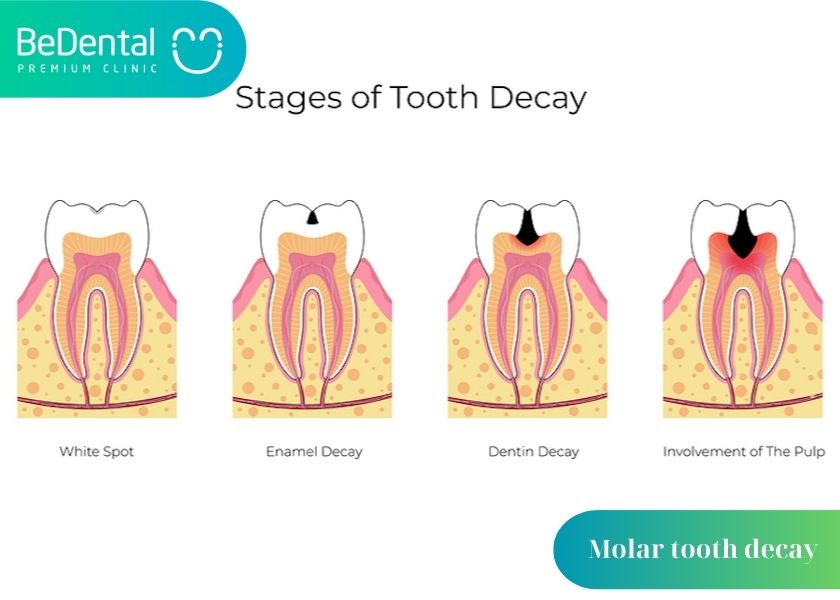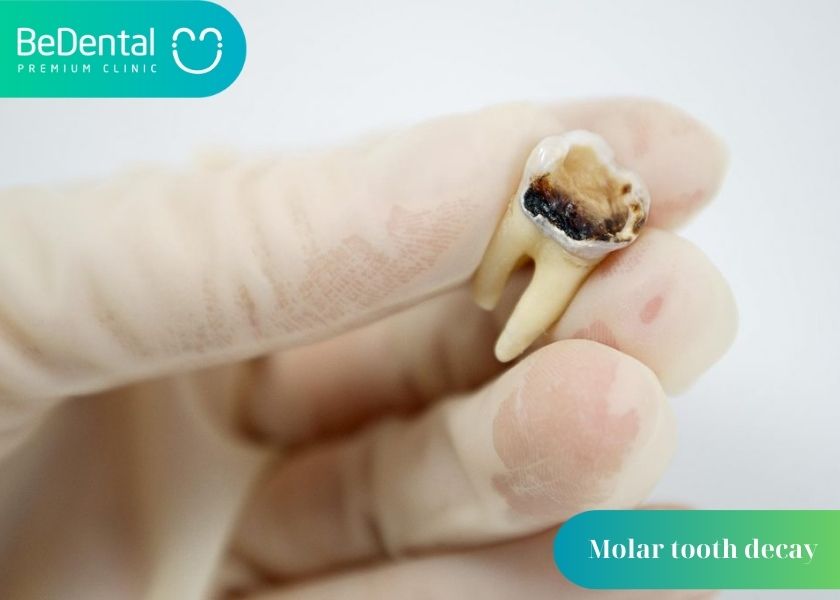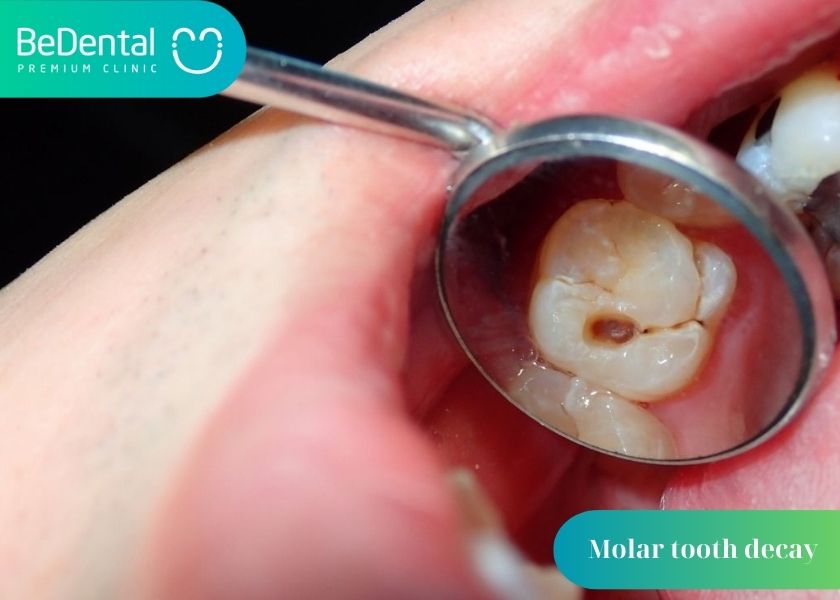Should decayed molars be extracted? Is molar extraction painful? Is molar extraction dangerous? How much does it cost to extract molars? All questions about broken, painful or decayed molars will be answered by BeDental in the article below, please read.
Why is decayed molar so common?
Molar position
- Molars are also known by another name as molars. These are the teeth that grow in the innermost position. It is responsible for chewing and grinding food and protecting the jawbone.
- Each adult will have 16 – 20 molars. Each jaw will have 8 – 10 symmetrical molars.
- Premolars next to canines are molars number 4 and molars number 5. These are molars that grow to replace baby molars.
- Large molars are the innermost teeth, belonging to teeth number 6 and tooth number 7. These are the permanent molars. Therefore, it only grows once in its life and does not grow again.
- In addition, tooth number 8 is also counted as a molar. It is the last molar to grow, but losing it will not affect it. Even in many cases of wisdom tooth decay, tooth number 8 is required to be removed.
The reason why molars are more susceptible to decay than other teeth
Molar tooth decay often occurs because molars are responsible for the main chewing function in the jaw. It is characterized by a lot of contact with food, and is located inside, so it is often attacked by bacteria, destroying tooth enamel.
Molars are located deep inside, so when they are decayed, they will be very difficult to detect. We often discover tooth decay when there is pain or severe decay.
When tooth decay begins, you may observe loss of tooth enamel. Or brown streaks appear on the tooth surface. However, these initial manifestations are not too obvious. Therefore, few people pay attention to it.

Degrees of tooth decay
Decayed molars are divided into many different levels:
- Stage 1: Molar cavities begin to form
At this time, there are only ivory white spots on the molars, no black streaks. Patients often cannot feel anything on their teeth.
- Stage 2: Cavities form with small black holes
Ivory white spots, when not detected and treated promptly, will form small black holes. This hole tends to spread and begins to attack tooth enamel and dentin.
At this time, the feeling of molar pain more or less appears. In particular, when eating food that is too hot or too cold, the feeling of molar pain becomes more obvious.
- Stage 3: The black spot of the worm spreads to the pulp
At this stage, tooth decay has progressed seriously and spread to other organizations. Can damage neighboring teeth and spread to the pulp. The pain appears more, especially at night.
- Stage 4: Molar tooth decay damages the pulp
This is the heaviest stage. Tooth decay destroys the pulp, causing pulp death, gingivitis, periodontitis, etc.

Should decayed molars be extracted?
As we know, molars are extremely important teeth. Especially teeth number 6 and number 7. They are permanent teeth, once lost, they cannot grow back.
Therefore, you should take care of your molars to avoid dental disease attacks. Although molars can be extracted, immediately afterward, you must have a method to restore aesthetic dentures immediately. This is to prevent complications of tooth and jaw bone loss, deformity, sunken cheeks, etc.
Molars decay due to many different reasons. However, not all cases require this tooth to be removed. Specifically:
In case the molars are decayed, they can be preserved
Molar tooth decay can be preserved and does not need to be removed when the tooth decay is mild. Or the level of decay does not greatly affect the root of the tooth. Specifically, the following cases:
- When mortar is in the early stages. The level of decay only stops at the tooth enamel. At this point, the doctor only needs to clean and fill the molars. This is an effective and safe method of treating tooth decay without causing tooth loss.
- The molar has decayed into the pulp but has not affected the tooth root. The dentin is intact, so the doctor only needs to treat the root canal and fill the crown. In this case, even though the tooth has dead pulp, it can still ensure chewing function. The doctor can cover the decayed tooth with porcelain to preserve the tooth.
Note: After all tooth decay areas have been treated and the treatment is successful. Oral hygiene is essential to maintain daily because cavities can return. Especially teeth that have had root canals, porcelain crowns, and fillings. Besides, when chewing hard objects, you need to pay attention to avoid affecting your teeth.
In case the molars are decayed, they need to be extracted
Extracting decayed molars is a mandatory case that needs to be performed in cases where tooth decay is too severe. Specifically, severe tooth decay stimulates the tooth pulp, attacks the tooth root and eats deep into the jawbone.
In addition, it is necessary to extract the upper molar or the decayed lower molar when the tooth root has been amputated. Accompanied by gum recession, periodontitis,…

Does removing lower molars have any effects?
With molars that are decayed and need to be removed, you need to face consequences such as:
- Chewing force is significantly reduced, food grinding is affected. Therefore, the digestive system may have to work harder.
- Losing a molar will cause the chewing force to be concentrated on the remaining teeth. This makes the teeth in the jaw susceptible to weakening due to being subjected to greater force than normal over a long period of time.
- Misaligned bite due to no longer having teeth that are symmetrical to the opposing jaw. This leads to the risk of swelling, gingivitis, periodontitis, etc.
- If there is no method to restore tooth loss, the risk of tooth bone loss will occur. And when jawbone loss occurs, the teeth will shift and affect the bite. Some serious complications due to bone loss are sunken cheeks, wrinkled skin, sagging skin, etc.
Methods of treating decayed molars
For each condition of decayed molars, the treatment method will be different. Specifically, below are 3 popular methods of treating decayed molars:
Filling cavities in molars
This is the most optimal solution for mildly decayed molars. At this time, black holes are just forming on the tooth surface. Because it does not affect the inside or other teeth, real teeth can be preserved.
When filling a deep molar, the doctor will choose the appropriate filling material. It can be composite fillings, silver fillings, etc. to compensate for missing tooth tissue. The lifespan of dental fillings can be 3 – 5 years depending on how each person maintains them.

See more: How long does dental filling last? Important considerations after dental filling
Porcelain crowns for decayed molars
To treat decayed molars, you can refer to the porcelain crown method. With this technique, the doctor needs to grind down the decayed tooth. Then meticulously prepare the tooth base and craft a suitable porcelain crown.
The advantage of the porcelain crown method for cavities is that it ensures both aesthetics and chewing function. When you eat food that is too hot or too cold, you will not feel pain or sensitivity. Furthermore, this method also ensures safety and longevity.
Removing decayed molars
This is the final indication if the tooth decay has become too severe. At this time, filling or porcelain coating methods cannot completely treat cavities, causing them to continue to spread. And to protect neighboring teeth, tooth extraction is a must. The cost of molar extraction and implantation will be specifically informed by the doctor.
Is it okay if a molar is broken? How to treat?
Molars break due to many different reasons. It could be due to strong external forces or severe tooth decay. Because the more severe the tooth decay, the greater the tooth damage. The number of broken pieces has also increased since then. If not treated early, the tooth will have its entire body or root exposed.
Is there anything wrong with broken or broken molars?
Broken or broken molars combined with tooth decay can lead to many serious consequences. The more the tank is in a broken position, the more food is trapped. Furthermore, the gums in between the teeth often crawl in to fill the cavities. These gums are prone to swelling and bleeding.
When a decayed molar is not intervened or treated early, it will cause widespread infection. The infection quickly spreads to surrounding teeth. Left uncontrolled, inflammation can damage the jawbone and affect nerves and blood vessels.
How to treat decayed and broken molars?

With decayed molars that still have roots, the treatment process is quite complicated. Depending on each case, the doctor will have the optimal treatment plan. Specifically:
If the tooth root is still good
If the tooth root is in good condition and the tooth tip infection has not spread, the doctor will proceed:
- Clean around the tooth root area, remove all excess gums that are covering the tooth roots.
- The remaining tooth root will be treated with a root canal. Depending on the location, the doctor will open the pulp of the upper molar or open the pulp of the lower molar. Then, remove the inflamed pulp from the tooth root, clean and fill the root canal.
- Depending on how much hard tissue remains, the dentist will reconstruct the tooth crown. This helps make teeth stronger when wearing porcelain crowns.
- Finally, there is a porcelain crown to protect the teeth. At the same time, it increases aesthetics and ensures chewing function.
If the tooth root is not good
In case the molar is broken, has tooth decay and the tooth root is not good, the treatment plan is as follows:
- Remove the tooth root and clean out the infection in the tip area. This helps avoid the risk of infection and dangerous complications.
- After that, the doctor will proceed to make dentures to restore chewing function. Depending on each customer’s needs, the type of denture will be chosen accordingly.

Answers to some questions about tooth extraction
Is molar extraction painful?
Is molar extraction painful? Molars with decay need to be extracted. However, most customers feel worried because they are afraid of pain.
Don’t worry, go to a reputable dental clinic like BeDental to experience painless molar extraction services. With Piezotome technology, the molar extraction process is quick, painless and does not cause too much damage. Recovery after tooth extraction is also much faster than with traditional methods.
Is tooth extraction dangerous?
Molars are teeth that have a different position compared to other teeth. Because it is located deep inside the jaw frame, it will be more difficult to remove. In addition, molars have many roots, so the necessary extraction is carried out by a team of reputable dentists, combined with modern supporting machinery.
As long as you choose a reputable dentist, you will not have to worry about any danger occurring. Prioritize choosing a dental clinic with many years of experience. At the same time, choose highly qualified doctors and the most modern supporting machinery.
If you choose an unreliable address, you may experience prolonged bleeding after tooth extraction. In addition, infection or nerve damage may occur.

How much does it cost to have a molar extracted?
How much does it cost to have a molar extracted? How much it costs to have a molar extracted is also an issue that many people are concerned about. Depending on each dental clinic, the cost of molar extraction will vary.
Currently, the price of molar extraction will range from 800,000 – 4,500,000 VND depending on the tooth location, oral disease condition and implementation technology. To receive accurate prices, you should call Hotline to get the latest quote.
BeDental’s above article has helped you learn all the issues related to decayed molars. Please come directly to our clinic to get specific advice from the doctor. Or call the Hotline to receive a price list for tooth extraction that is painless and without dangerous complications.
BEDENTAL - TOP STANDARD DENTISTRY SYSTEM
In HANOI
Address 1: 7B Thi Sach St, Ngo Thi Nham, Hai Ba Trung Dist, Ha Noi. - 0934.61.9090
Address 2: No 129 Hoang Ngan, Yen Hoa, Cau Giay Dist, Ha Noi. - 0934.61.9090
In HO CHI MINH
Address 1: 53 -55 -57 Pho Duc Chinh St, Nguyen Thai Binh, Dist. 1, Ho Chi Minh. - 0766.00.8080
Working: 9am - 8pm everyday
Website: https://bedental.vn/en/




